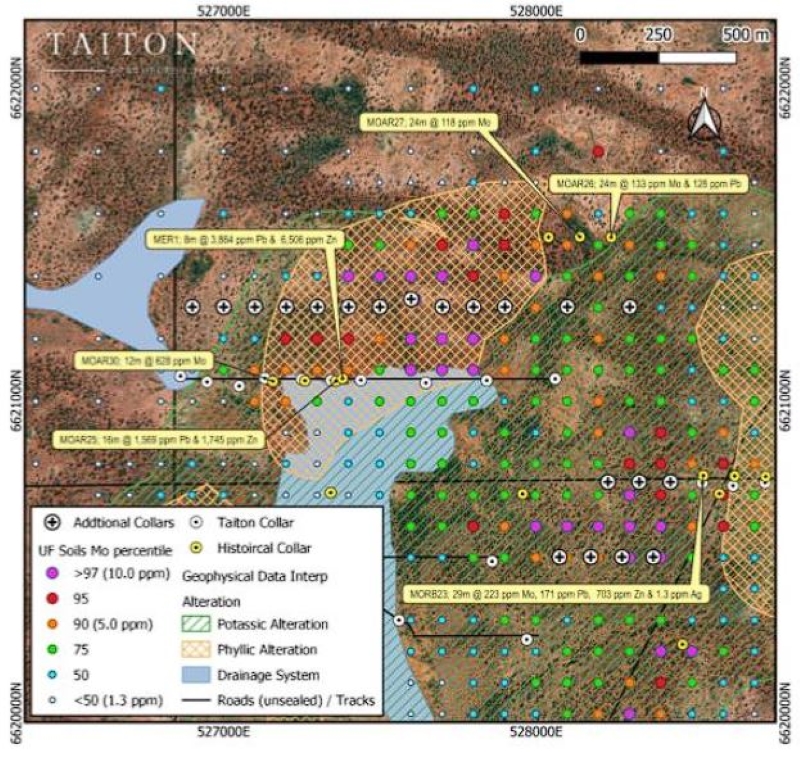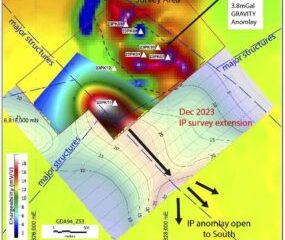Uncategorized
Taiton discovers ‘broad footprint of molybdenum’ at flagship Highway project
Special Report: If you drive from Adelaide up to Alice Springs, you might pass by a chunk of land that … Read More
The post Taiton discovers ‘broad…

- UltraFine soil sampling has identified over 2.5km of strike containing multiple molybdenum cores
- 22 RC holes have been drilled at the Merino prospect and assays are pending
- New drill targets have been identified in the northern region of the soil sample area
If you drive from Adelaide up to Alice Springs, you might pass by a chunk of land that Taiton Resources (ASX:T88) reckons contains very large, molybdenum-rich orebodies under surface.
Smack bang in the middle of one of Australia’s most mineralised regions, South Australia’s Gawler Craton, Taiton’s aptly named Highway project contains geochemical anomalism that tick all the boxes for a large hydrothermal system.
Hydrothermal systems can contain porphyry, skarn, VMS, SEDEX and Epithermal/ Mississippi type deposits. All very different with one thing in common – they can be monstrous.
Molybdenum surge
Molybdenum (Mo) is primarily used as an additive in alloy steels to improve strength, toughness and weldability for a range of applications in manufacturing processes such as carmaking, shipbuilding, construction, as well as mining, chemical, oil & gas and energy industries.
Global production has been weighed down and prices have spiked, due to output challenges in both China and South America.
With the West’s mandate to shore up allied and domestic supply chains, there’s a good reason for companies such as Taiton to look to prove up an economic resource.
Samples lead exploration north
1,122 soil samples were taken at the highly prospective Merino prospect at the Highway project across an area ~4km x 4.5km to identify the geochemical anomalism and to target the most prospective areas for the next drill campaign.
Molybdenum was found to be encapsulating cores with a higher tenor molybdenum in the northern area of the sample region where a coherent molybdenum anomaly area has been discovered.
Together with the molybdenum anomalism, Taiton found anomalous base and precious metals, as well as prospective hydrothermal alteration signatures including phyllic, propylitic and potassic alteration, identified from the IP data and rock samples collected in the field.
This, the explorer says, is reflective of hydrothermal mineralisation – a perfect setting to host high quantities of molybdenum and other metals.
“The UltraFine soil results have given us important information that supports the fertility of the Merino prospect and the anomalous molybdenum,” Taiton exec director Noel Ong says.
“The northern region is anomalous in other elements as well, which indicates a mineralising event that is consistent with our exploration strategy.
“There is a region measuring 500m x almost 1km that is of great interest for our upcoming drilling program.”

Drilling completed at Merino, assays coming
A maiden 22-hole RC drill program for 3,062m has been completed at Merino prospect, which Taiton says was to primarily test the IP anomalism and delineate the geological setting of the mineralisation that’s beneath the surface.
While assays have been sent to the lab for analysis, the explorer says preliminary geological assessments of the holes have confirmed the source of the chargeable anomalism target to be disseminated pyrite, ranging from a volume of <1% to 10%.
To further analyse this, chip tray samples have been taken from hole HRC23-008 which illustrates areas of propylitic alteration (green minerals) within quartzite, down hole between 18-79m.
“To assist with understanding the alteration assemblages the chip trays have been sent to the South Australian Geological Survey where they with be scanned using the HyLogger system,” Taiton says.
“This work will complement the assays (both drill hole and Ultrafine soil sampling) and the geophysical datasets to help inform the potential geological model and direct future exploration programs.”
Next steps
Taiton says exploration will now focus on the high-priority molybdenum anomalism in the northern area of the Highway project where potential molybdenum mineralisation may be preserved.
Further exploration will then move outwards to distal lower tenor molybdenum and associated pathfinder anomalism.
These areas of lower tenor anomalism may reflect areas where the roof of the intrusion is deeper, and the overlying metasediment (quartzite) offers a greater prospect of preserving potential mineralisation.
“As we await assays for our completed drilling program, we are very happy to see the results from the UltraFine soil survey identifying a broad region of molybdenum results,” Ong says.
“The path forward for Taiton is now about the next drilling program to test the molybdenum anomalism and using the UltraFine soils sampling process on the other regional exploration areas within our Highway project.”
This article was developed in collaboration with Taiton Resources, a Stockhead advertiser at the time of publishing.
This article does not constitute financial product advice. You should consider obtaining independent advice before making any financial decisions.
The post Taiton discovers ‘broad footprint of molybdenum’ at flagship Highway project appeared first on Stockhead.


















